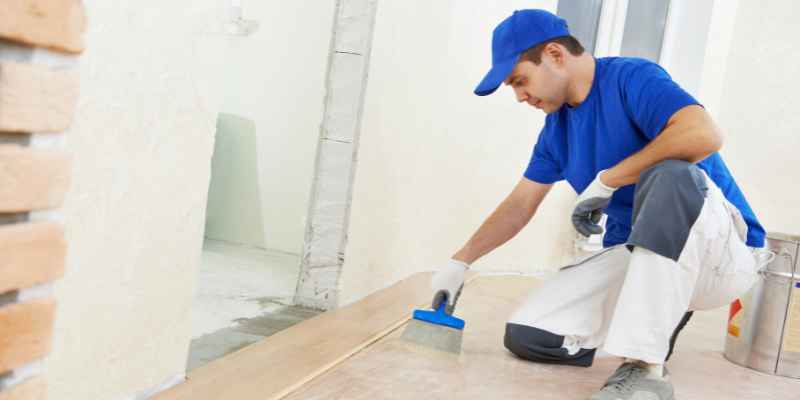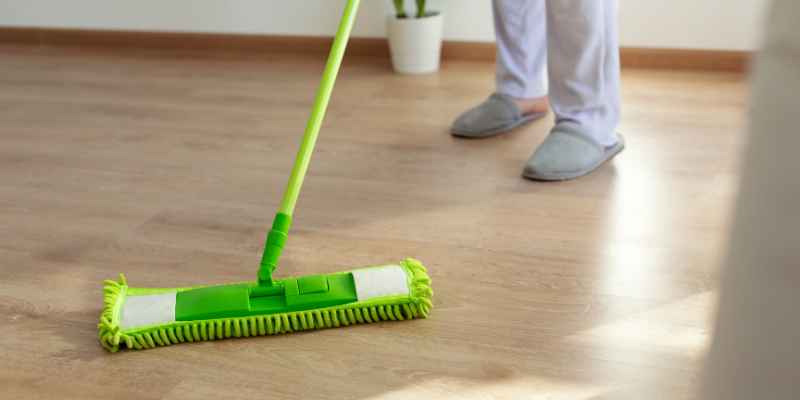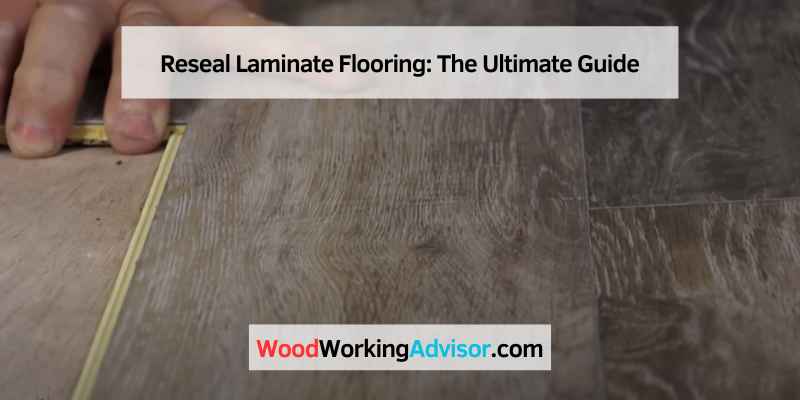Yes, laminate flooring can be resealed. Applying a laminate flooring sealant to the joints only can make the flooring more moisture resistant.
However, it is important to keep in mind that laminate flooring is a floating floor and it expands and contracts with temperature changes. To properly reseal laminate flooring, it is important to follow the right process. Laminate flooring is a popular choice for homeowners for its durability and affordability.
However, over time, it can become scratched, faded, or damaged due to moisture. To keep the flooring in good condition, it is important to reseal it as needed. We will discuss the process of resealing laminate flooring and answer some frequently asked questions about laminate flooring maintenance. We will also provide some tips on how to revive old laminate flooring to give it a like-new appearance.

How To Prepare Laminate Flooring For Resealing
Before resealing laminate flooring, it is important to clean the surface thoroughly. Begin by sweeping or vacuuming to remove debris, then using a damp mop and mild cleaner to remove any dirt or stains. Allow the floor to dry completely before applying the sealant, which can help protect the flooring from moisture and wear.
If you want to keep your laminate flooring looking fresh and new for years to come, then resealing it is a must. Resealing helps to protect the laminate from moisture, scratches, and daily wear and tear, ensuring it lasts for longer. However, before you start resealing, you need to prepare your flooring properly. Here’s how.
Cleaning The Floor
Before you start resealing your laminate flooring, you need to make sure that it’s clean. Sweep the floor to remove any dust and debris, and then mop it with a mild cleaner and warm water. Make sure you wring out your mop well so that the floor doesn’t get too wet, as this can cause damage to the laminate.
Removing Stains And Previous Sealant
If there are any stains on your laminate flooring, use a mixture of baking soda and water to remove them. Apply the mixture to the stain and let it sit for a few minutes before wiping it away with a damp cloth. If your laminate flooring has been previously sealed, you’ll need to remove the old sealant before applying a new one. Use a paint stripper or sandpaper to remove the old sealant, being careful not to damage the laminate.
Sanding The Surface
Once you’ve removed any stains and old sealant, use sandpaper to sand the surface of the laminate flooring. Sanding helps to remove any rough spots, giving the sealant a smooth surface to adhere to. Make sure you use a fine-grit sandpaper and work in the direction of the wood grain.
Removing Dust And Debris
After sanding, remove any dust and debris from the floor. Use a vacuum cleaner or a damp cloth to pick up any loose particles. Make sure you let the floor dry completely before applying any sealant.
Now that you know how to prepare your laminate flooring for resealing, you can ensure that your flooring will last for years to come. These steps might seem tedious, but they are crucial in ensuring that the sealant adheres properly and the laminate flooring is protected from daily wear and tear.
Choosing The Right Sealant For Your Laminate Flooring
When resealing your laminate flooring, it is important to choose the right sealant. Laminate flooring is a floating floor, so it expands and contracts with temperature changes. Applying laminate flooring sealant to the joints only can make your flooring more moisture resistant.
When it comes to ensuring the longevity of your laminate flooring, choosing the right sealant is important. Sealants protect your flooring from moisture and give it a durable finish. However, with many different types of sealants available, each with their own pros and cons, it can be challenging to decide which is right for your particular flooring. In this blog post, we will explore the factors to consider when choosing a sealant, the different types of sealants and their pros and cons, and application methods for different sealants.
Factors to Consider when Choosing a Sealant
Before you invest in any sealant, it’s essential to consider the following factors:
– Purpose: Why are you looking to seal your laminate flooring? Do you want to protect it from moisture? Add durability? Enhance its look? Knowing the purpose will help you choose the right sealant.
– Ingredients: Take a look at the ingredients list. Ensure that the sealant you choose doesn’t contain harsh chemicals that could damage your laminate flooring. Opt for sealants that use water-based or green chemistry ingredients.
– Durability: Your sealant’s durability is essential as it determines how long your floors will be protected. Consider sealants that offer long-lasting protection.
– Ease of application: A sealant that’s easy to apply will save you money and time. Look for those that come in easy-to-use packaging and simple-to-follow instructions.
Different Types of Sealants and Their Pros and Cons
There are four main types of laminate flooring sealants, each with its pros and cons:
1. Acrylic Sealants: Acrylic sealants are water-based and easy to apply. They offer great protection against moisture and are suitable for high-traffic areas. However, they are not as durable as other types of sealants.
2. Polyurethane Sealants: Polyurethane sealants are available in water or oil-based variants. They offer excellent durability and protection against moisture. However, they are expensive, harder to apply, and have powerful odors during the application process.
3. Epoxy Sealants: Epoxy sealants are known for their superior durability and strength. They create a thick coating on the laminate flooring, offering extra protection against moisture. Unlike the others, Epoxy sealants require professional application.
4. Wax Seals: Wax seals are an affordable solution that provides an easy-to-clean surface. However, they offer minimum protection against moisture and are susceptible to scratches and scuffs.
Application Methods for Different Sealants
Once you have chosen the right sealant type, the next step is to ensure that you apply it correctly. Some common methods to apply sealants include:
– Brushing: Suitable for thick sealants like polyurethane and epoxy, brushing ensures even coverage and helps fill in gaps and cracks.
– Spraying: Best for acrylic sealants, spraying allows for a thin, even coat and is easy to apply for large areas.
– Pouring and Spreading: Best for wax sealants, this method involves pouring the sealant onto the laminate flooring and spreading it with a foam brush or mop applicator.
In conclusion, choosing the right sealant for your laminate flooring is essential to ensure it lasts longer and remains protected against moisture. Consider the purpose, ingredients, durability, and ease of application before selecting a sealant. Choose from acrylic, polyurethane, epoxy, or wax sealants based on their pros and cons listed, and apply according to the recommended method.
How To Apply Sealant On Laminate Flooring
Resealing laminate flooring is an easy process that can be done by applying laminate flooring sealant to the joints only. Since laminate flooring is a floating floor, it is important to make sure that the sealant is applied correctly at the joints to make it more moisture resistant.
Laminate flooring is a popular flooring option due to its durability, affordability, and easy maintenance. However, if you want to make your laminate flooring more moisture-resistant, applying a sealant can be a great solution. Applying the sealant may seem like a daunting task, but with the right tools and materials, it can be done with ease. In this section, we will walk you through the step-by-step process of applying sealant on laminate flooring, including gathering necessary tools and materials, applying the first coat of sealant, allowing the first coat to dry, and applying the second coat of sealant.
Gather Necessary Tools And Materials
Before you begin the process of applying sealant on your laminate flooring, it’s important to have all the necessary tools and materials. Here are the things you’ll need:
- Sealant
- Paintbrush or foam brush
- Clean cloth
- Masking tape
- Protective gloves
- Respirator mask
Applying The First Coat Of Sealant
Once you have all the necessary tools and materials, it’s time to apply the first coat of sealant. Follow these steps:
- Clean your laminate flooring thoroughly using a clean cloth to remove any dust and dirt.
- Apply masking tape around the edges of the room to avoid getting sealant on the baseboard or wall.
- Wear protective gloves and a respirator mask to avoid inhaling fumes.
- Apply a thin and even coat of sealant on the laminate flooring using a paintbrush or foam brush. Start from a corner and slowly work your way towards the other end of the room.
- Make sure to apply sealant on all the edges of the laminate flooring to avoid any water damage.
Allowing The First Coat To Dry
After applying the first coat of sealant, you need to allow it to dry before applying the second coat. Follow these steps:
- Leave the first coat of sealant to dry for at least 24 hours.
- Once the first coat has dried, inspect the laminate flooring for any missed spots or bubbles.
- If you find any missed spots or bubbles, gently sand them out using sandpaper and apply a small amount of sealant on those areas using a paintbrush or foam brush.
- Allow the sealant to dry for another 24 hours before applying the second coat.
Applying The Second Coat Of Sealant
After the first coat of sealant has dried completely, it’s time to apply the second and final coat of sealant. Follow these steps:
- Apply the second coat of sealant following the same steps as the first coat.
- Make sure the second coat is a bit thicker than the first coat to ensure maximum protection.
- Allow the second coat to dry for at least 24 hours before walking or placing any furniture on the laminate flooring.
- After the second coat has completely dried, carefully remove the masking tape to reveal a newly sealed laminate flooring.
In conclusion, applying sealant on laminate flooring can be a simple process if you follow the steps correctly. By following these steps, you can protect your laminate flooring from moisture damage and prolong its lifespan.
Maintenance Tips For Resealed Laminate Flooring
If you have resealed your laminate flooring, congratulations! Your floors will now be much more protected from moisture, scratches, and general wear and tear. However, even with sealing, your floors still need proper maintenance to ensure they last for years to come. Here are some useful maintenance tips to keep in mind.
Avoiding Water Damage
While resealing your laminate floors makes them more resistant to water, it’s still important to take precautionary measures to prevent any damage. This includes not allowing any standing water or spills to sit on the floors for an extended period. Be sure to dry any spills immediately and avoid using wet mops or cleaners. Instead, use a damp mop or cloth to clean up any spills.
Regular Cleaning Habits
To maintain the appearance and longevity of your resealed laminate floors, it’s essential to establish a regular cleaning routine. You should sweep or vacuum regularly to remove any dirt and debris that can scratch the floors. Use a soft-bristle broom or vacuum attachment to avoid any damage. In addition, occasionally damp mop the floors with a laminate floor cleaning solution, making sure to wring the mop out thoroughly before use to avoid any excess water.
Avoiding Harsh Chemicals
When resealing laminate floors or cleaning them, it’s crucial to avoid using harsh chemicals. These can damage the sealant and affect the overall appearance and durability of the floors. Instead, use mild cleaning solutions specifically designed for laminate floors. You can also make your own cleaning solution with a mixture of warm water and a small amount of vinegar or dish soap.
Periodic Resealing
While resealing can add an extra layer of protection to your laminate floors, it’s not permanent. You should plan to reseal your floors periodically, depending on the foot traffic and wear and tear. You will know it’s time to reseal when water no longer beads on the surface of your laminate floors. If you’re unsure, testing a small, inconspicuous area can help you determine if your floors need resealing.

Common Problems With Resealed Laminate Flooring
Resealed laminate flooring can experience common problems such as bubbles, delamination and chipping. It is important to properly seal the joints during installation and regularly maintain the flooring to prevent these issues from occurring. Applying laminate flooring sealant to the joints can increase moisture resistance, but be careful not to make the surface completely waterproof as it may cause the flooring to buckle.
Resealing your laminate flooring is a great way to protect it from scratches, spills, and other types of damage. However, there are some common problems that you may encounter when resealing your laminate flooring that you should be aware of. In this section, we will discuss some of the most common problems that people face when resealing their laminate flooring and how you can avoid them.
Bubbles and Wrinkles
One of the most common problems that people face when resealing their laminate flooring is the appearance of bubbles and wrinkles on the surface of the flooring. This can be caused by using too much sealant or by not allowing the sealant to dry properly. To avoid this problem, make sure that you apply the sealant in thin, even layers and allow each layer to dry completely before applying the next one.
Uneven Application
Another common problem that people face when resealing their laminate flooring is uneven application. This can result in some areas of the floor being over-sealed while others are not adequately protected. To avoid this problem, make sure that you apply the sealant evenly across the entire surface of the flooring, taking care to cover all areas evenly.
Peeling and Chipping
Peeling and chipping can also be a problem when resealing laminate flooring. This can be caused by using a low-quality sealant or not allowing the sealant to dry properly between coats. To avoid this problem, make sure that you use a high-quality sealant and allow each coat to dry completely before applying the next one.
Staining and Discoloration
Finally, staining and discoloration can be a problem when resealing laminate flooring. This can be caused by using a sealant that is not compatible with the flooring, or by not properly cleaning or preparing the surface of the flooring before applying the sealant. To avoid this problem, make sure that you use a sealant that is designed for use with laminate flooring, and take the time to properly prepare the flooring before applying the sealant.
In conclusion, resealing your laminate flooring is a great way to protect it from damage, but it’s important to be aware of the common problems that you may encounter when doing so. By following the tips and advice outlined above, you can avoid these problems and ensure that your resealed laminate flooring looks great and provides the protection that you need.
Frequently Asked Questions Of Reseal Laminate Flooring
Can Laminate Flooring Be Resealed?
It is okay to apply laminate flooring sealant to the joints only to make it more moisture-resistant. However, laminate flooring cannot be resealed completely as it is a floating floor that expands and contracts with temperature changes. Sanding off the glossy layer and applying a new layer of paint or sealer is possible but a tedious task.
Can You Recoat Laminate Flooring?
Yes, laminate flooring can be recoated with a new layer of paint or sealer after carefully sanding down the glossy finish. However, this work is usually tedious and requires expertise. Applying laminate flooring sealant to the joints can also make it moisture resistant but not waterproof since laminate flooring is a floating floor that expands and contracts with temperature changes.
How Do You Fix A Laminate Floor That Is Lifting?
To fix a laminate floor that is lifting, you can get a trusted expert to assess and fix the problem, trim the expansion gap, make sure the underlay is fitted properly, fix any water damage, or seal the joints with laminate flooring sealant.
You can also use a wax pencil to fill in minor scratches or sand and refinish the floor if necessary.
How Do You Revive Old Laminate Flooring?
To revive old laminate flooring, fill in minor scratches with a wax pencil designed for laminate flooring. Rub the wax over the scratch until it’s filled and wipe away any excess wax with a soft cloth. Applying laminate flooring sealant to the joints only can also make it more moisture resistant.
Laminate flooring expands and contracts with temperature changes, so do not apply sealant all over.
Conclusion
Resealing laminate flooring can protect it from water damage and scratches, prolonging its lifespan. Whether you are looking to make it more moisture-resistant or rejuvenate old flooring, there are several options available. From using laminate flooring sealant to filling in scratches with a wax pencil, taking the necessary steps to maintain your flooring can save you time and money in the long run.
Seek the assistance of a trusted expert when necessary to ensure that the job is done correctly.


